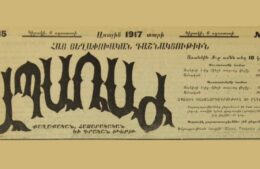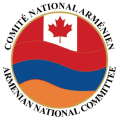Book Review: Jodi Magness’ ‘Jerusalem Through the Ages’ Spotlights Armenians of Jerusalem
- (0)

BY ARTHUR HAGOPIAN
Jerusalem, the city of gold, the city of light. Thousands of books have been written about it, each in its way depositing another tile onto the city’s fascinating mosaic, exploring and expounding the enigma and magic of this eternal city sacred to more than half the population of our planet: the Christians, the Moslems and the Jews.
And now along comes another tome to cap them all: “Jerusalem Through the Ages,” by eminent archaeologist and author Jodi Magness.
Who asks herself, tongue in cheek: “Why do we need another book about Jerusalem?” and proceeds to explain the rationale behind her new and monumental 600-page oeuvre.
She is not worried her book will be buried under the towering sheaves of paper whose contents embody the story of every cobblestoned alley, nook and cranny, every bit of remains and ruins left behind by the passage of history.
Most of the “many excellent” books about Jerusalem deal with the city’s premodern history and are written either by “non-specialists, are edited volumes containing chapters by multiple specialists or are studies written by individual specialists focusing on a specific time frame or topic,” Magness points out.
Her book is different because what it presents is a refreshingly “broad survey authored by a single specialist.”
It makes for slow, careful reading. No skipping paragraphs or pages: as one peruses the meticulously crafted text, one becomes overwhelmed by the sheer wealth of detail and the feeling that this is one journey to be embarked upon without extraneous distractions.
Published by Oxford University Press, the book enraptures us with the history of Jerusalem from its beginnings to the Crusades.
One is awed by the painstaking task the author has set herself, digging up such a multitudinous plethora of the details, tidbits and nuggets some of which revealed for the first time, to the astonishment and delight of even those who profess to know the city, or the land, well.
Like the revelation that some 1,000 scrolls had been discovered in 11 caves at Qumran.
Or the assault on the senses when she re-enacts the entry into the city of various conquerors, some walking into the city barefoot or shirtless in homage and humility, in contrast with members of the city’s ruling elite who opted for extravagant displays of opulence.
Reading enjoyment is enhanced by the presence of over 100 black and white photographs and maps, and over a dozen color plates, some taken by the author herself from intriguingly fresh angles.
But as though not satisfied with the pages of copious notes and an extended bibliography, the author takes into consideration the wish of readers to see the city and bask in its many attractions for themselves, by offering them a gratifying guide for walking tours.
Magness is aware of the importance of the city’s Armenian link in the enchanting fabric of Jerusalem, and has therefore devoted a special section of the book to their story, concentrating on the Byzantine era.
We worked together with Daniel Ferguson, the Canadian director of “Jerusalem The Movie,” an ambitious 3D IMAX production that aimed to explore the lines of intersection of the three Abrahamic religions: Christianity, Islam and Judaism.
But when I asked her if a sequel for her book was in the works, she said it was unlikely. “Even the Crusades was a stretch for me,” she added.
Armenians have played key roles in helping place Jerusalem on the map – they gave the city its first printing press and photographic studio. They have also given to the world the musician and composer Ohan Durian, the philosopher Haig Khatchadourian and the theologian Apraham Terian, among other luminaries.
Armenians have been living in Jerusalem long before their acceptance of Christianity as a state religion in 301 CE: they could very well have settled there a 100 years before Jesus, arriving in the region with the armies of their king, Tigranes II.
They came all the way from their mountainous homeland, on the backs of donkeys, mules, camels, their caravans sometimes stretching to 300 beasts of burden.
Magness quotes the Armenian historian Anastas, who reported there were some 60 Armenian establishments in the city in the 6th and 7th Centuries. Telling evidence of their presence is etched in the Bird Mosaic, in the city’s Musrara neighborhood, now housed in the Edward and Helen Mardigian museum in the Convent of St James, enhanced by the discovery nearby of another mosaic, a medallion a few years ago.
Not too far away, archaeologists also discovered a broken marble cross inscribed in Armenian, ”having remembered Petros who made it and Yohan who commissioned” it.
The total number of Armenians in the Holy Land has been put at 25,000 at their peak, circa 1948, yet despite the relentless attrition that has shrunk their number to a fraction of that, their contribution to the grandeur and glory of Jerusalem continues unabated, as their artists continue to regale visitors with their incomparable handiwork.
The author recalls that the Armenian compound in the Old City was the site of the encampment of the Tenth Legion of Rome which raided the Zealot enclave at Masada, a fact that reinforces the historic connection between the two peoples. The Jewish cemetery by the river Eghegis in Armenia, recently renovated, offers further testimony to that.
The book is a worthy addition to the library of all those who love Jerusalem but undeniably it will not be the last book to be written about this enigma “so rich in remains, so incredibly layered and complex that it is impossible to know everything about it,” as Magness puts it.
“It is the meeting place of heaven and earth and the locus of divine and human interaction,” she goes on to add.
And for the Armenians specifically, ranking as the second fount of spiritual rejuvenation, after the cathedral of Etchmiadzin in Yerevan.


















